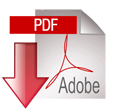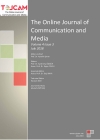TOJCAM - Volume 3 - Issue 3 - July 2017
 POSTER AS A MEANS OF COMMUNICATION IN EDUCATION: METHODOLOGICAL AND APPLIED ASPECTS OF DESIGN
POSTER AS A MEANS OF COMMUNICATION IN EDUCATION: METHODOLOGICAL AND APPLIED ASPECTS OF DESIGN Irina Hristoforova, Alexandra Demenkova, Tatiana N. Arkhipova, Tamara I. Krasikova, Valentina V. Krishtopaytis
Abstract:
The relevance of the research is due to the existence of the poster design features as a means of communication
in education.
Objective. To identify the methodological, pedagogical, marketing, art graphic design features incorporated in
the design of contemporary posters in education.
Research methods. Such scientific methods as logical and content analysis, comparison of analogues and
groups are used as research tools. These methods have allowed systematizing the methodological aspects of
graphic design and applying them at the implementation of specific project.
Results of the research. The article presents the results of theoretical generalizations of the history of the
emergence and development of the poster as a means of communication and artistic work. It shows systematized
elements, rules, principles and techniques of graphic design used in posters creation, identifies techniques of
graphic design used in poster production, justifies the specific character of posters used in education in sphere of
service provision.
Practical significance. Article submissions are of practical value, since they have formed the basis for poster
designing for the University Open Day and can be used in the educational process in future.
 PRACTICAL SUGGESTIONS FOR ACADEMIC COLLABORATION BETWEEN DISCIPLINES IN THE FACULTIES OF COMMUNICATION
PRACTICAL SUGGESTIONS FOR ACADEMIC COLLABORATION BETWEEN DISCIPLINES IN THE FACULTIES OF COMMUNICATION H. Hale KUNUCEN
Abstract:
Communication Faculties of Turkey, there are various departments which focus on different disciplines of
communication. Some of these are Public Relations, Radio, TV and Cinema, Journalism, Visual Communication
Design and Communication Design. These departments only educate students to be competent in the related
discipline. However, through interdisciplinary approaches and collaboration between departments, they may
receive more fruitful and effective educational achievements which will enable them to develop their academic,
personal and professional competencies. In this study some practical suggestions will be put forward and
discussed with special references to educational contexts in different universities in Turkey.
 TEACHING DATA DRIVEN JOURNALISM: HOW TO INTEGRATE DATA SCIENCE INTO EXISTING CURRICULA SHOWN IN THE EXAMPLE OF A JOURNALISM PROGRAM AT THE BACHELOR’S DEGREE LEVEL
TEACHING DATA DRIVEN JOURNALISM: HOW TO INTEGRATE DATA SCIENCE INTO EXISTING CURRICULA SHOWN IN THE EXAMPLE OF A JOURNALISM PROGRAM AT THE BACHELOR’S DEGREE LEVEL Birgit OBERER, Alptekin ERKOLLAR, Anna Stein
Abstract:
Developing an integrative curriculum has become a globally discussed issue and challenging for all institutions of
higher education. Curriculum development is a multi-step process which is undertaken after every specified period
defined by an educational institution. Though it may vary from university to university, generally it is a four to five
years period with ongoing updates and revisions. Data journalism is thriving worldwide, but what is missing from
data journalism education? This question is addressed in this study by applying the Stanford University
Berret-Phillips approach for modeling curricula in teaching data and computational journalism for a 6-semester
journalism program at the Bachelor's Degree Level in am European University. After a qualitative state of the art
analysis of the program, the journalism program's curriculum was enriched with the dimension ‘data science', (1)
by implementing data science as a core course and (2) by integrating data science into existing courses and
concentrations. The results of the study revealed that offering a three-dimensional data science education with (1)
integration of data science components in traditional journalism courses, (2) offering fundamental courses in
data-driven journalism as well as (3) offering a specialization in data journalism for students interested in
advanced skills, is essential for a journalism programs in Higher Education to equip students with data skills for a
data journalist.
 USEFULNESS OF MODELLING MEDIA AS PERCEIVED BY FINE AND APPLIED ARTS STUDENTS OF AHMADU BELLO UNIVERSITY, ZARIA, NIGERIA
USEFULNESS OF MODELLING MEDIA AS PERCEIVED BY FINE AND APPLIED ARTS STUDENTS OF AHMADU BELLO UNIVERSITY, ZARIA, NIGERIA Michael Olubunmi ODEWUMI
Abstract:
Modelling is a functional 3 dimensional arts, a fascinating creation of objects, easy to manipulate and meeting
higher technical requirements. Empirical verifications confirm students are scared of modelling because of the
media employed, scarcity of the media and seeming tediousness in modelling activities employing such media.
With this background, this study was carried out to investigate usefulness of modelling media as perceived by
fine and applied arts students of Ahmadu Bello University, Zaria, Nigeria. Survey research design was
employed, with purposive sampling, constituting 114 students: 40 females, 74 males; of 200 to 400 levels.
Questionnaire was employed as research instrument, subjected to content and face validation by experts. Two
hypotheses were tested at 0.05 level of significance using ANOVA and T-TEST. The outcome revealed that
there was significant difference in usefulness of modelling media as perceived by fine and applied arts students
of Ahmadu Bello University, Zaria, Nigeria; and gender was a factor. Recommendation was made that students
be exposed to different modelling media right from 200 level to improve and encourage modelling skill.


